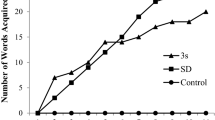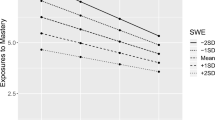Abstract
The effects of SMART Board technology, an interactive electronic whiteboard, and a 3s constant time delay (CTD) procedure was evaluated for teaching sight word reading to students with moderate intellectual disabilties within a small group arrangment. A multiple probe design across three word sets and replicated with three students was used to evaluate the effectiveness of SMART Board technology on: (a) reading target grocery words; (b) matching grocery item photos to target grocery words; (c) reading other students’ target grocery words through observational learning; and (d) matching grocery item photos to observational grocery words. Results support use of this tool to teach multiple students at one time and its effects on observational learning of non-target information.





Similar content being viewed by others
References
Baumgart, D., & VanWalleghem, J. (1987). Teaching sight words: A comparison between computer-assisted and teacher-made methods. Education and Training in Mental Retardation, 22, 56–65.
Billingsley, F. F., White, O. R., & Munson, R. (1980). Procedural reliability: A rationale and an example. Behavioral Assessment, 2, 229–241.
Boone, R., Higgins, K., Notari, A., & Stump, C. S. (1996). Hypermedia pre-reading lessons: Learner-centered software for kindergarten. Journal of Computing in Childhood Education, 7, 39–69.
Brewer N., White J. M., & Brand L. (1991–1992). Computerized instruction of word discriminations with retarded children: An examination of two whole-word fading procedures. Journal of Educational Technology Systems, 20, 31–43.
Coleman-Martin, M. B., Heller, W. K., Cihak, D. F., & Irvine, K. L. (2005). Using computer-assisted instruction and the nonverbal reading approach to teach word identification. Focus on Autism and Other Developmental Disabilties, 20, 80–90.
Collins, B. C., Gast, D. L., Ault, M. J., & Wolery, M. (1991). Small group instruction: Guidelines for teachers of students with moderate to severe handicaps. Education and Training in Mental Retardation, 26, 18–32.
Collins B. C., & Stinson D. M. (1994–1995). Teaching generalized reading of product warning labels to adolescents with mental disabilities through the use of key words. Exceptionality, 5, 163–181.
Conners, F. A. (1990). Aptitude by treatment interactions in computer-assisted word learning by mentally retarded students. American Journal on Mental Retardation, 94, 387–397.
Conover Company. Grocery signs and words. [Computer Software]. Available at http://www.conovercompany.com
Cuvo, A. J., & Klatt, K. P. (1992). Effects of community-based, videotape, and flash card instruction of community-referenced sight words on students with mental retardation. Journal of Applied Behavior Analysis, 25, 499–512.
Doyle, P. M., Gast, D. L., Wolery, M., Ault, M. J., & Meyer, S. (1992). Teaching discrete skills to students with moderate mental retardation in small-group instructional arrangements. Exceptionality, 3, 233–253.
Farmer, J. A., Gast, D. L., Wolery, M., & Winterling, V. (1991). Small group instruction for students with severe handicaps: A study of observational learning. Education and Training in Mental Retardation, 26, 121–132.
Farmer, M. E., Klein, R., & Bryson, S. E. (1992). Computer-assisted reading: Effects of whole-word feedback on fluency and comprehension in readers with severe disabilities. Remedial and Special Education, 13, 50–60.
Fickel, K. M., Schuster, J. W., & Collins, B. C. (1998). Teaching different tasks using different stimuli in a heterogeneous small group. Journal of Behavioral Education, 8, 219–244.
Gast, D. L., & Winterling, V. (1992). Teaching first-aid skills to students with moderate handicaps in small group instruction. Education and Treatment of Children, 15, 101–124.
Griffen, A. K., Wolery, M., & Schuster, J. W. (1992). Triadic instruction of chained food preparation responses: Acquisition and observational learning. Journal of Applied Behavior Analysis, 25, 193–204.
Hall, M. G., Schuster, J. W., Wolery, M., Gast, D. L., & Doyle, P. M. (1992). Teaching chained skills in a non-school setting using a divided half instructional format. Journal of Behavioral Education, 2, 257–279.
Heimann, M., Nelson, K. E., Tjus, T., & Gillberg, C. (1995). Increasing reading and communication skills in children with autism through an interactive multimedia computer program. Journal of Autism and Developmental Disorders, 25, 459–480.
Holcombe, A., Wolery, M., Werts, M. G., & Hrenkevick, P. (1993). Effects of instructive feedback on future learning. Journal of Behavioral Education, 3, 259–285.
Judge, S. L. (2001). Computer applications in programs for young children with disabilities. Journal of Special Education Technology, 16, 29–40.
Keel, M. C., & Gast, D. L. (1992). Small-group instruction for students with learning disabilities: Observational and incidental learning. Exceptional Children, 58, 357–369.
Lee, Y., & Vail, C. O. (2005). Computer-based reading instruction for young children with disabilities. Journal of Special Education Technology, 20, 5–18.
Lowe’s Food Stores, Inc. (2005). Lowe’s foods to go grocery shopping on line. http://www.lowesfoods.com
Mechling, L. C. (2004). Effects of multimedia, computer-based instruction on grocery shopping fluency. Journal of Special Education Technology, 19, 23–34.
Mechling, L. C., & Gast, D. L. (2003). Multi-media instruction to teach grocery word associations and store location: A study of generalization. Education and Training in Developmental Disabilities, 38, 62–76.
Microsoft. PowerPoint. [Computer Program]. Available at http://www.microsoft.com
Okolo, C. M., Bahr, C. M., & Rieth, H. J. (1993). A restrospective view of computer-based instruction. Journal of Special Education Technology, 12, 1–27.
Schoen, S. F., & Ogden, S. (1995). Impact of time delay, observational learning, and attentional cuing upon word recognition during integrated small-group instruction. Journal of Autism and Developmental Disorders, 25, 503–519.
Schuster, J. W., Morse, T. E., Griffen, A. B., & Wolery, T. (1996). Teaching peer reinforcement and grocery words: An investigation of observational learning and instructive feedback. Journal of Behavioral Education, 6, 511–533.
Stinson, D. M., Gast, D. L., Wolery, M., & Collins, B. C. (1991). Acquisition of nontargeted information during small-group instruction. Exceptionality, 2, 65–80.
Tawney, J.W., & Gast, D.L. (1984). Single subject research in special education. Columbus, OH: Merrill.
Technologies, Inc. (2003). SMART Board Interactive Whiteboard.
Thorkildsen, R. J., & Friedman, S. G. (1986). Interactive videodisc: Instructional design of a beginning reading program. Learning Disability Quarterly, 9, 111–117.
Thorndike, R. L., Hagen, E., & Sattler, J. (1986). Standford-Binet intelligence scale: Fourth edition. Chicago: Riverside.
Tjus, T., Heimann, M., & Nelson, K. E. (1998). Gains in literacy through the use of a specially developed multimedia computer strategy. Autism, 22, 139–156.
Wall, M. E., & Gast, D. L. (1999). Acquisition of incidental information during instruction for a response-chain skill. Research in Developmental Disabilities, 20, 31–50.
Wechsler, D. (1997). Wechsler adult intelligence scale-III. San Antonio, TX: Psychological Corporation.
Werts, M. G., Wolery, M., Holcombe, A., & Gast, D. L. (1995). Instructive feedback: Review of parameters and effects. Journal of Behavioral Education, 5, 55–75.
Whalen, C., Schuster, J. W., & Hemmeter, M. L. (1996). The use of unrelated instructive feedback when teaching in a small group instructional arrangement. Education and Training in Mental Retardation and Developmental Disabilities, 31, 188–202.
Williams, C., Wright, B., Callaghan, G., & Coughlan, B. (2002). Do children with autism learn to read more readily by computer assisted instruction or traditional book methods? Autism, 6, 71–91.
Wolery, M., Ault, M. J., Doyle, P. M., Gast, D. L., & Griffen, A. K. (1992). Choral and individual responding during small groupinstruction: Identification of interactional effects. Education and Treatment of Children, 15, 289–309.
Wolery, M., Ault, M. J., Gast, D. L., Doyle, P. M., & Griffen, A. K. (1991). Teaching chained tasks in dyads: Acquisition of target and observational behaviors. The Journal of Special Education, 25, 198–220.
Wolery, M., Doyle, P. M., Ault, M. J., & Gast, D. L. (1992). Reflections on teaching discrete skills to students with moderate mental retardation in small-group instructional arrangements. Exeptionality, 3, 265–270.
Wolery, M., Doyle, P. M., Ault, M. J., Gast, D. L., Meyer, S., & Stinson, D. (1991). Effects of presenting incidental information in consequent events on future learning. Journal of Behavioral Education, 1, 79–104.
Wolery, M., Schuster, J., & Collins, B. (2000). Effects on future learning of presenting non-target stimuli in antecedent and consequent conditions. Journal of Behavioral Education, 10, 77–94.
Author information
Authors and Affiliations
Corresponding author
Rights and permissions
About this article
Cite this article
Mechling, L.C., Gast, D.L. & Krupa, K. Impact of SMART Board Technology: An Investigation of Sight Word Reading and Observational Learning. J Autism Dev Disord 37, 1869–1882 (2007). https://doi.org/10.1007/s10803-007-0361-9
Received:
Accepted:
Published:
Issue Date:
DOI: https://doi.org/10.1007/s10803-007-0361-9




